A Gap in Service Delivery in Health & Social Care
VerifiedAdded on 2023/01/07
|12
|3708
|54
AI Summary
This paper discusses the issue of a gap in service delivery in health and social care in Australia, specifically focusing on the Aboriginal and Torres Strait Islander community. It explores the nature and implications of this gap and proposes a methodology to improve health outcomes for indigenous communities. The paper also highlights the role of Aboriginal Community Controlled Health Services (ACCHS) in addressing this gap and provides recommendations for policy and practice improvements.
Contribute Materials
Your contribution can guide someone’s learning journey. Share your
documents today.

Proposal
Secure Best Marks with AI Grader
Need help grading? Try our AI Grader for instant feedback on your assignments.
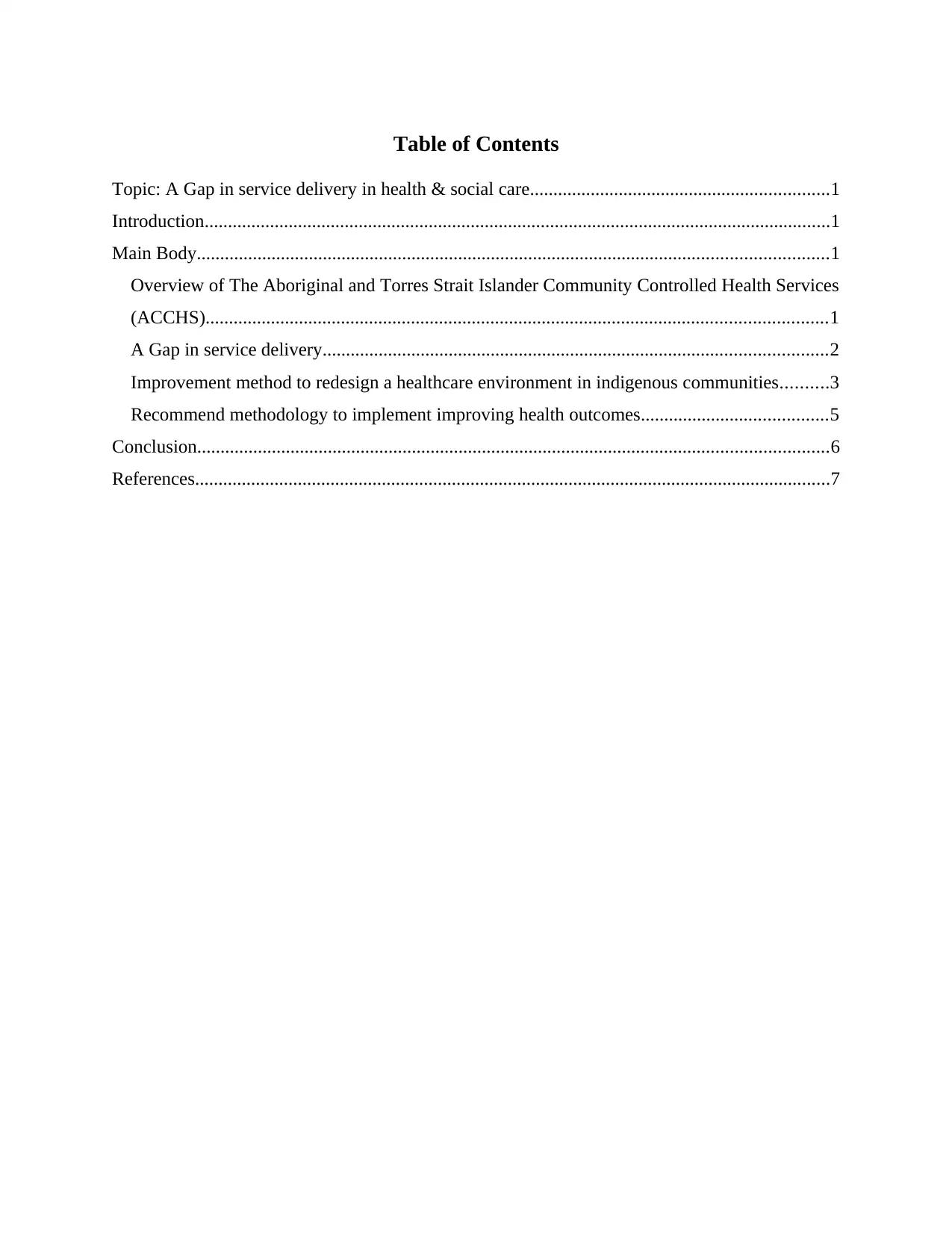
Table of Contents
Topic: A Gap in service delivery in health & social care................................................................1
Introduction......................................................................................................................................1
Main Body.......................................................................................................................................1
Overview of The Aboriginal and Torres Strait Islander Community Controlled Health Services
(ACCHS).....................................................................................................................................1
A Gap in service delivery............................................................................................................2
Improvement method to redesign a healthcare environment in indigenous communities..........3
Recommend methodology to implement improving health outcomes........................................5
Conclusion.......................................................................................................................................6
References........................................................................................................................................7
Topic: A Gap in service delivery in health & social care................................................................1
Introduction......................................................................................................................................1
Main Body.......................................................................................................................................1
Overview of The Aboriginal and Torres Strait Islander Community Controlled Health Services
(ACCHS).....................................................................................................................................1
A Gap in service delivery............................................................................................................2
Improvement method to redesign a healthcare environment in indigenous communities..........3
Recommend methodology to implement improving health outcomes........................................5
Conclusion.......................................................................................................................................6
References........................................................................................................................................7
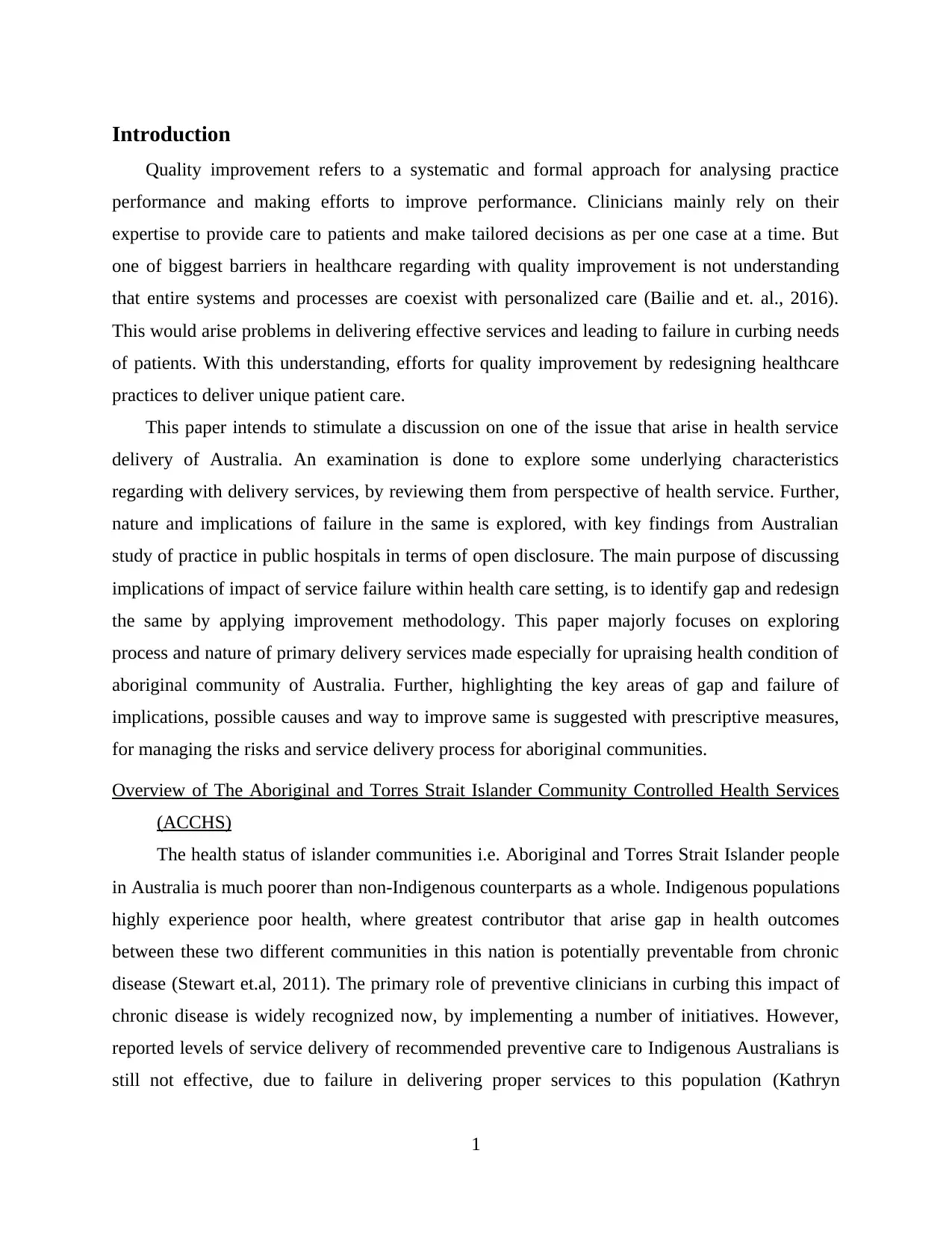
Introduction
Quality improvement refers to a systematic and formal approach for analysing practice
performance and making efforts to improve performance. Clinicians mainly rely on their
expertise to provide care to patients and make tailored decisions as per one case at a time. But
one of biggest barriers in healthcare regarding with quality improvement is not understanding
that entire systems and processes are coexist with personalized care (Bailie and et. al., 2016).
This would arise problems in delivering effective services and leading to failure in curbing needs
of patients. With this understanding, efforts for quality improvement by redesigning healthcare
practices to deliver unique patient care.
This paper intends to stimulate a discussion on one of the issue that arise in health service
delivery of Australia. An examination is done to explore some underlying characteristics
regarding with delivery services, by reviewing them from perspective of health service. Further,
nature and implications of failure in the same is explored, with key findings from Australian
study of practice in public hospitals in terms of open disclosure. The main purpose of discussing
implications of impact of service failure within health care setting, is to identify gap and redesign
the same by applying improvement methodology. This paper majorly focuses on exploring
process and nature of primary delivery services made especially for upraising health condition of
aboriginal community of Australia. Further, highlighting the key areas of gap and failure of
implications, possible causes and way to improve same is suggested with prescriptive measures,
for managing the risks and service delivery process for aboriginal communities.
Overview of The Aboriginal and Torres Strait Islander Community Controlled Health Services
(ACCHS)
The health status of islander communities i.e. Aboriginal and Torres Strait Islander people
in Australia is much poorer than non-Indigenous counterparts as a whole. Indigenous populations
highly experience poor health, where greatest contributor that arise gap in health outcomes
between these two different communities in this nation is potentially preventable from chronic
disease (Stewart et.al, 2011). The primary role of preventive clinicians in curbing this impact of
chronic disease is widely recognized now, by implementing a number of initiatives. However,
reported levels of service delivery of recommended preventive care to Indigenous Australians is
still not effective, due to failure in delivering proper services to this population (Kathryn
1
Quality improvement refers to a systematic and formal approach for analysing practice
performance and making efforts to improve performance. Clinicians mainly rely on their
expertise to provide care to patients and make tailored decisions as per one case at a time. But
one of biggest barriers in healthcare regarding with quality improvement is not understanding
that entire systems and processes are coexist with personalized care (Bailie and et. al., 2016).
This would arise problems in delivering effective services and leading to failure in curbing needs
of patients. With this understanding, efforts for quality improvement by redesigning healthcare
practices to deliver unique patient care.
This paper intends to stimulate a discussion on one of the issue that arise in health service
delivery of Australia. An examination is done to explore some underlying characteristics
regarding with delivery services, by reviewing them from perspective of health service. Further,
nature and implications of failure in the same is explored, with key findings from Australian
study of practice in public hospitals in terms of open disclosure. The main purpose of discussing
implications of impact of service failure within health care setting, is to identify gap and redesign
the same by applying improvement methodology. This paper majorly focuses on exploring
process and nature of primary delivery services made especially for upraising health condition of
aboriginal community of Australia. Further, highlighting the key areas of gap and failure of
implications, possible causes and way to improve same is suggested with prescriptive measures,
for managing the risks and service delivery process for aboriginal communities.
Overview of The Aboriginal and Torres Strait Islander Community Controlled Health Services
(ACCHS)
The health status of islander communities i.e. Aboriginal and Torres Strait Islander people
in Australia is much poorer than non-Indigenous counterparts as a whole. Indigenous populations
highly experience poor health, where greatest contributor that arise gap in health outcomes
between these two different communities in this nation is potentially preventable from chronic
disease (Stewart et.al, 2011). The primary role of preventive clinicians in curbing this impact of
chronic disease is widely recognized now, by implementing a number of initiatives. However,
reported levels of service delivery of recommended preventive care to Indigenous Australians is
still not effective, due to failure in delivering proper services to this population (Kathryn
1
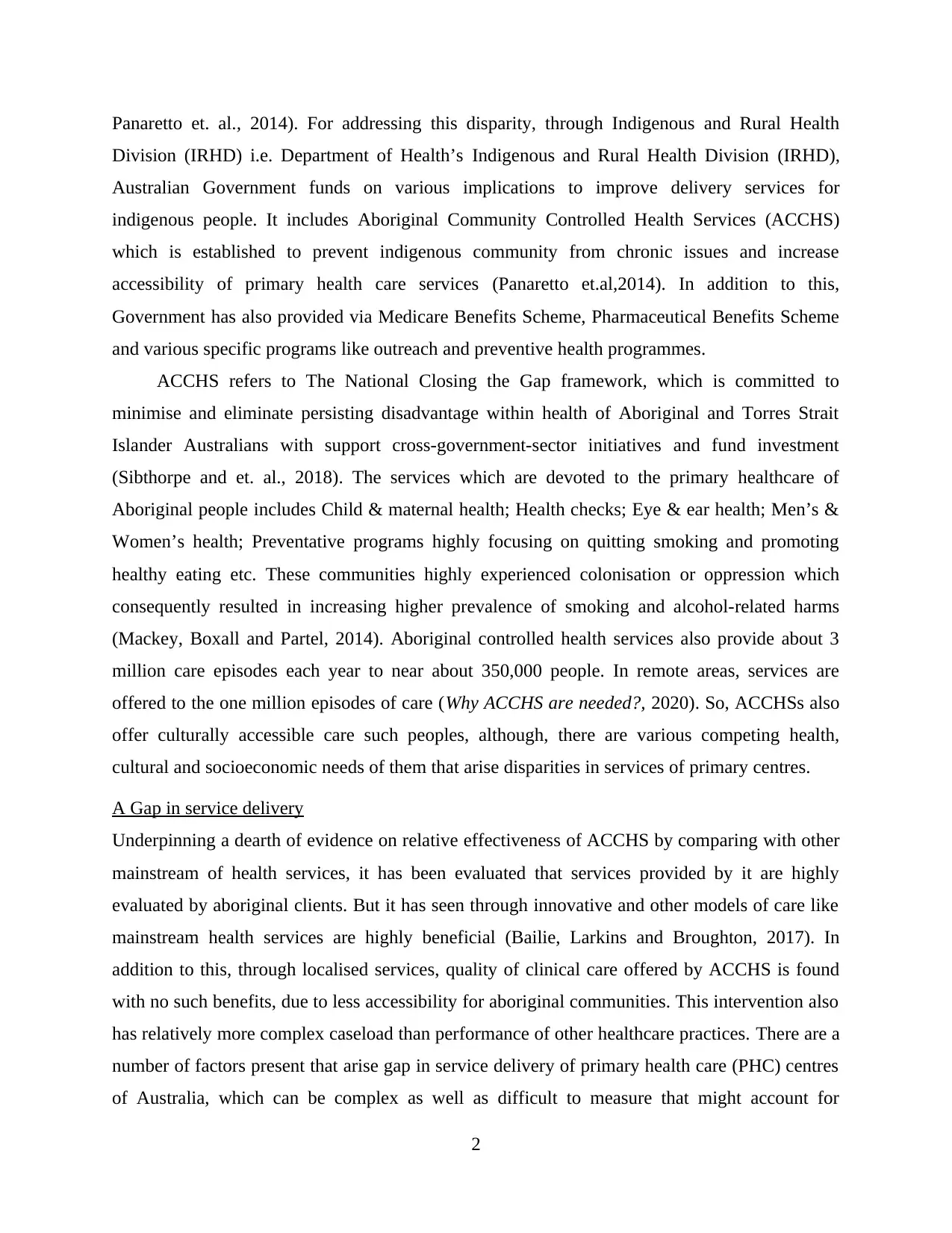
Panaretto et. al., 2014). For addressing this disparity, through Indigenous and Rural Health
Division (IRHD) i.e. Department of Health’s Indigenous and Rural Health Division (IRHD),
Australian Government funds on various implications to improve delivery services for
indigenous people. It includes Aboriginal Community Controlled Health Services (ACCHS)
which is established to prevent indigenous community from chronic issues and increase
accessibility of primary health care services (Panaretto et.al,2014). In addition to this,
Government has also provided via Medicare Benefits Scheme, Pharmaceutical Benefits Scheme
and various specific programs like outreach and preventive health programmes.
ACCHS refers to The National Closing the Gap framework, which is committed to
minimise and eliminate persisting disadvantage within health of Aboriginal and Torres Strait
Islander Australians with support cross-government-sector initiatives and fund investment
(Sibthorpe and et. al., 2018). The services which are devoted to the primary healthcare of
Aboriginal people includes Child & maternal health; Health checks; Eye & ear health; Men’s &
Women’s health; Preventative programs highly focusing on quitting smoking and promoting
healthy eating etc. These communities highly experienced colonisation or oppression which
consequently resulted in increasing higher prevalence of smoking and alcohol-related harms
(Mackey, Boxall and Partel, 2014). Aboriginal controlled health services also provide about 3
million care episodes each year to near about 350,000 people. In remote areas, services are
offered to the one million episodes of care (Why ACCHS are needed?, 2020). So, ACCHSs also
offer culturally accessible care such peoples, although, there are various competing health,
cultural and socioeconomic needs of them that arise disparities in services of primary centres.
A Gap in service delivery
Underpinning a dearth of evidence on relative effectiveness of ACCHS by comparing with other
mainstream of health services, it has been evaluated that services provided by it are highly
evaluated by aboriginal clients. But it has seen through innovative and other models of care like
mainstream health services are highly beneficial (Bailie, Larkins and Broughton, 2017). In
addition to this, through localised services, quality of clinical care offered by ACCHS is found
with no such benefits, due to less accessibility for aboriginal communities. This intervention also
has relatively more complex caseload than performance of other healthcare practices. There are a
number of factors present that arise gap in service delivery of primary health care (PHC) centres
of Australia, which can be complex as well as difficult to measure that might account for
2
Division (IRHD) i.e. Department of Health’s Indigenous and Rural Health Division (IRHD),
Australian Government funds on various implications to improve delivery services for
indigenous people. It includes Aboriginal Community Controlled Health Services (ACCHS)
which is established to prevent indigenous community from chronic issues and increase
accessibility of primary health care services (Panaretto et.al,2014). In addition to this,
Government has also provided via Medicare Benefits Scheme, Pharmaceutical Benefits Scheme
and various specific programs like outreach and preventive health programmes.
ACCHS refers to The National Closing the Gap framework, which is committed to
minimise and eliminate persisting disadvantage within health of Aboriginal and Torres Strait
Islander Australians with support cross-government-sector initiatives and fund investment
(Sibthorpe and et. al., 2018). The services which are devoted to the primary healthcare of
Aboriginal people includes Child & maternal health; Health checks; Eye & ear health; Men’s &
Women’s health; Preventative programs highly focusing on quitting smoking and promoting
healthy eating etc. These communities highly experienced colonisation or oppression which
consequently resulted in increasing higher prevalence of smoking and alcohol-related harms
(Mackey, Boxall and Partel, 2014). Aboriginal controlled health services also provide about 3
million care episodes each year to near about 350,000 people. In remote areas, services are
offered to the one million episodes of care (Why ACCHS are needed?, 2020). So, ACCHSs also
offer culturally accessible care such peoples, although, there are various competing health,
cultural and socioeconomic needs of them that arise disparities in services of primary centres.
A Gap in service delivery
Underpinning a dearth of evidence on relative effectiveness of ACCHS by comparing with other
mainstream of health services, it has been evaluated that services provided by it are highly
evaluated by aboriginal clients. But it has seen through innovative and other models of care like
mainstream health services are highly beneficial (Bailie, Larkins and Broughton, 2017). In
addition to this, through localised services, quality of clinical care offered by ACCHS is found
with no such benefits, due to less accessibility for aboriginal communities. This intervention also
has relatively more complex caseload than performance of other healthcare practices. There are a
number of factors present that arise gap in service delivery of primary health care (PHC) centres
of Australia, which can be complex as well as difficult to measure that might account for
2
Secure Best Marks with AI Grader
Need help grading? Try our AI Grader for instant feedback on your assignments.
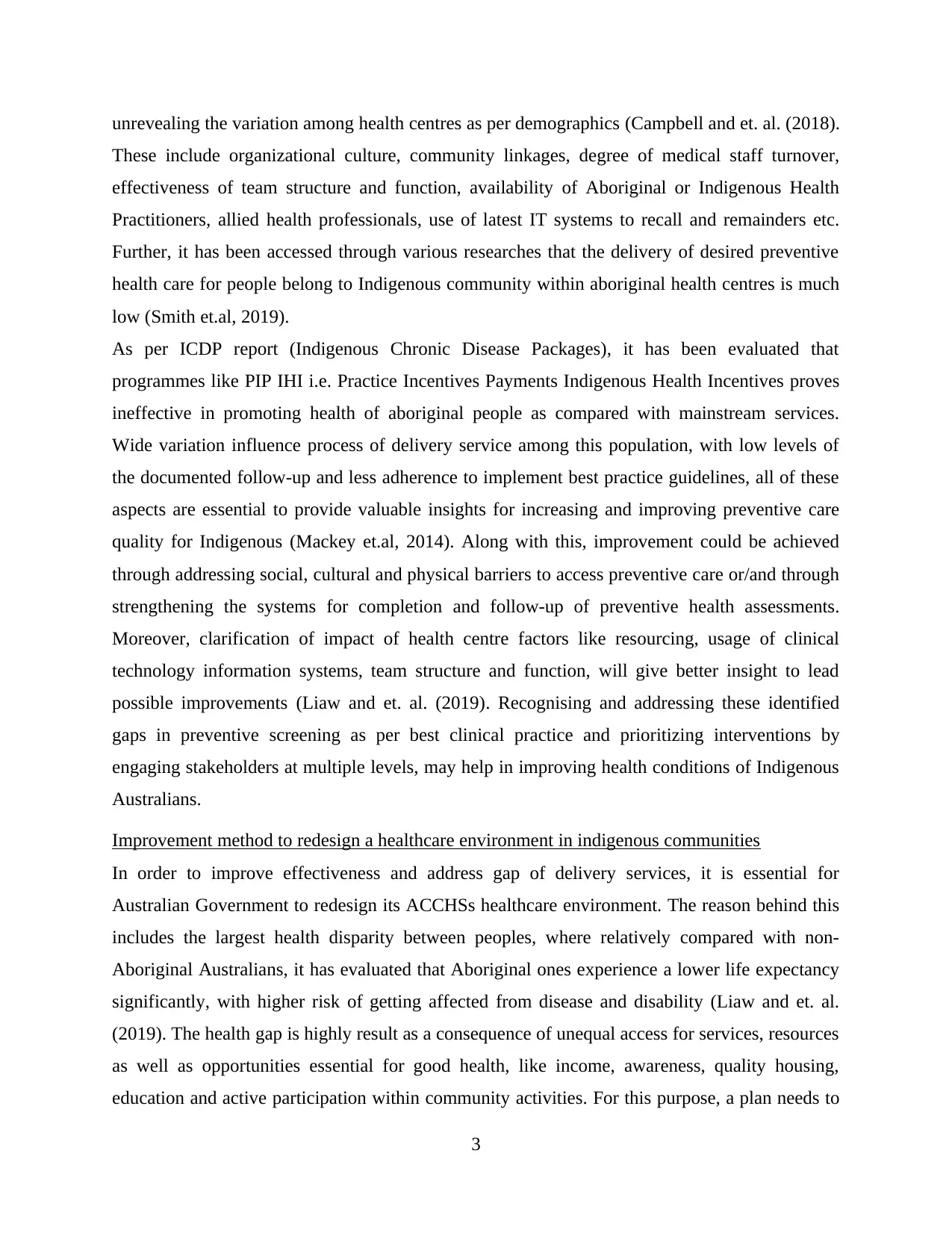
unrevealing the variation among health centres as per demographics (Campbell and et. al. (2018).
These include organizational culture, community linkages, degree of medical staff turnover,
effectiveness of team structure and function, availability of Aboriginal or Indigenous Health
Practitioners, allied health professionals, use of latest IT systems to recall and remainders etc.
Further, it has been accessed through various researches that the delivery of desired preventive
health care for people belong to Indigenous community within aboriginal health centres is much
low (Smith et.al, 2019).
As per ICDP report (Indigenous Chronic Disease Packages), it has been evaluated that
programmes like PIP IHI i.e. Practice Incentives Payments Indigenous Health Incentives proves
ineffective in promoting health of aboriginal people as compared with mainstream services.
Wide variation influence process of delivery service among this population, with low levels of
the documented follow-up and less adherence to implement best practice guidelines, all of these
aspects are essential to provide valuable insights for increasing and improving preventive care
quality for Indigenous (Mackey et.al, 2014). Along with this, improvement could be achieved
through addressing social, cultural and physical barriers to access preventive care or/and through
strengthening the systems for completion and follow-up of preventive health assessments.
Moreover, clarification of impact of health centre factors like resourcing, usage of clinical
technology information systems, team structure and function, will give better insight to lead
possible improvements (Liaw and et. al. (2019). Recognising and addressing these identified
gaps in preventive screening as per best clinical practice and prioritizing interventions by
engaging stakeholders at multiple levels, may help in improving health conditions of Indigenous
Australians.
Improvement method to redesign a healthcare environment in indigenous communities
In order to improve effectiveness and address gap of delivery services, it is essential for
Australian Government to redesign its ACCHSs healthcare environment. The reason behind this
includes the largest health disparity between peoples, where relatively compared with non-
Aboriginal Australians, it has evaluated that Aboriginal ones experience a lower life expectancy
significantly, with higher risk of getting affected from disease and disability (Liaw and et. al.
(2019). The health gap is highly result as a consequence of unequal access for services, resources
as well as opportunities essential for good health, like income, awareness, quality housing,
education and active participation within community activities. For this purpose, a plan needs to
3
These include organizational culture, community linkages, degree of medical staff turnover,
effectiveness of team structure and function, availability of Aboriginal or Indigenous Health
Practitioners, allied health professionals, use of latest IT systems to recall and remainders etc.
Further, it has been accessed through various researches that the delivery of desired preventive
health care for people belong to Indigenous community within aboriginal health centres is much
low (Smith et.al, 2019).
As per ICDP report (Indigenous Chronic Disease Packages), it has been evaluated that
programmes like PIP IHI i.e. Practice Incentives Payments Indigenous Health Incentives proves
ineffective in promoting health of aboriginal people as compared with mainstream services.
Wide variation influence process of delivery service among this population, with low levels of
the documented follow-up and less adherence to implement best practice guidelines, all of these
aspects are essential to provide valuable insights for increasing and improving preventive care
quality for Indigenous (Mackey et.al, 2014). Along with this, improvement could be achieved
through addressing social, cultural and physical barriers to access preventive care or/and through
strengthening the systems for completion and follow-up of preventive health assessments.
Moreover, clarification of impact of health centre factors like resourcing, usage of clinical
technology information systems, team structure and function, will give better insight to lead
possible improvements (Liaw and et. al. (2019). Recognising and addressing these identified
gaps in preventive screening as per best clinical practice and prioritizing interventions by
engaging stakeholders at multiple levels, may help in improving health conditions of Indigenous
Australians.
Improvement method to redesign a healthcare environment in indigenous communities
In order to improve effectiveness and address gap of delivery services, it is essential for
Australian Government to redesign its ACCHSs healthcare environment. The reason behind this
includes the largest health disparity between peoples, where relatively compared with non-
Aboriginal Australians, it has evaluated that Aboriginal ones experience a lower life expectancy
significantly, with higher risk of getting affected from disease and disability (Liaw and et. al.
(2019). The health gap is highly result as a consequence of unequal access for services, resources
as well as opportunities essential for good health, like income, awareness, quality housing,
education and active participation within community activities. For this purpose, a plan needs to
3
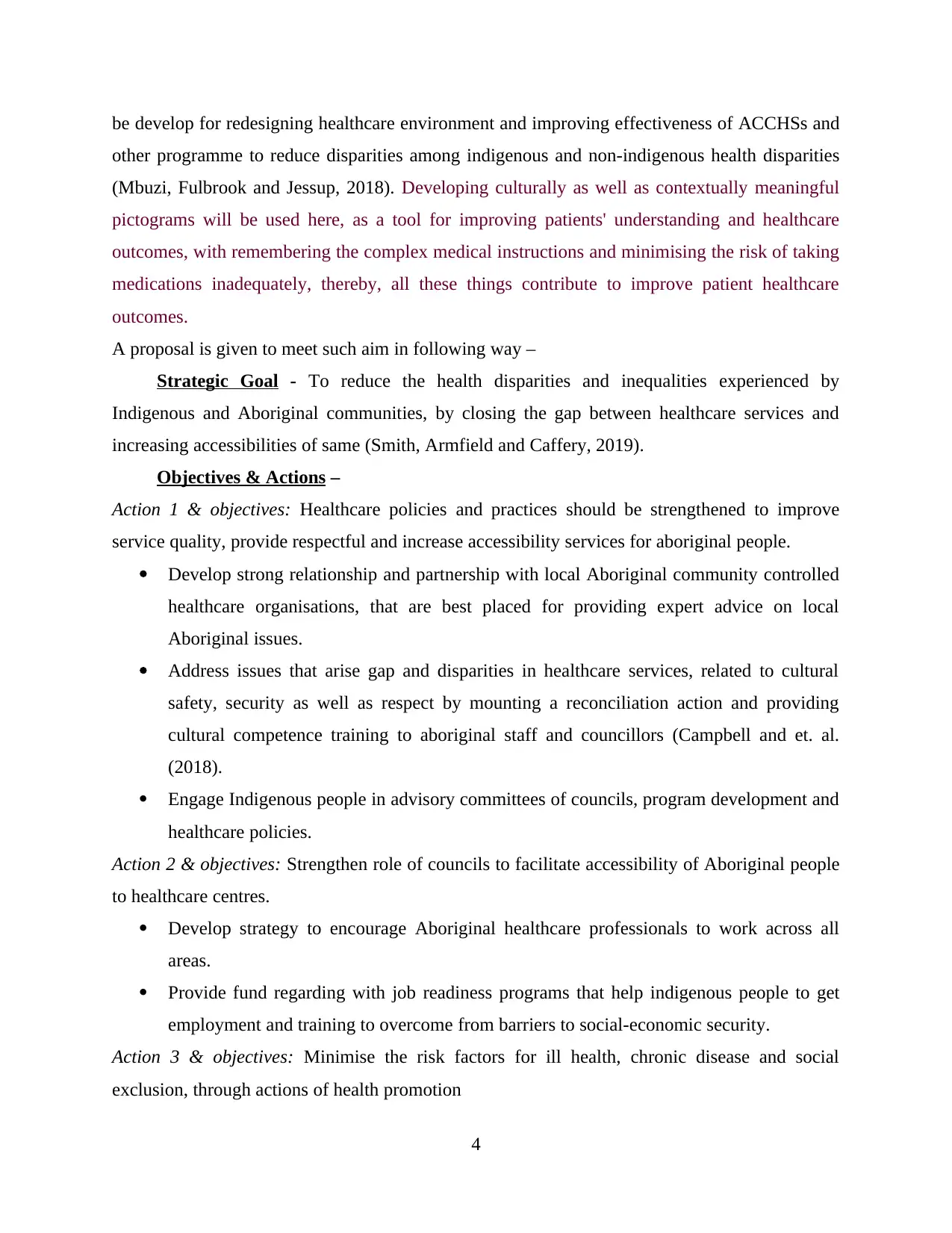
be develop for redesigning healthcare environment and improving effectiveness of ACCHSs and
other programme to reduce disparities among indigenous and non-indigenous health disparities
(Mbuzi, Fulbrook and Jessup, 2018). Developing culturally as well as contextually meaningful
pictograms will be used here, as a tool for improving patients' understanding and healthcare
outcomes, with remembering the complex medical instructions and minimising the risk of taking
medications inadequately, thereby, all these things contribute to improve patient healthcare
outcomes.
A proposal is given to meet such aim in following way –
Strategic Goal - To reduce the health disparities and inequalities experienced by
Indigenous and Aboriginal communities, by closing the gap between healthcare services and
increasing accessibilities of same (Smith, Armfield and Caffery, 2019).
Objectives & Actions –
Action 1 & objectives: Healthcare policies and practices should be strengthened to improve
service quality, provide respectful and increase accessibility services for aboriginal people.
Develop strong relationship and partnership with local Aboriginal community controlled
healthcare organisations, that are best placed for providing expert advice on local
Aboriginal issues.
Address issues that arise gap and disparities in healthcare services, related to cultural
safety, security as well as respect by mounting a reconciliation action and providing
cultural competence training to aboriginal staff and councillors (Campbell and et. al.
(2018).
Engage Indigenous people in advisory committees of councils, program development and
healthcare policies.
Action 2 & objectives: Strengthen role of councils to facilitate accessibility of Aboriginal people
to healthcare centres.
Develop strategy to encourage Aboriginal healthcare professionals to work across all
areas.
Provide fund regarding with job readiness programs that help indigenous people to get
employment and training to overcome from barriers to social-economic security.
Action 3 & objectives: Minimise the risk factors for ill health, chronic disease and social
exclusion, through actions of health promotion
4
other programme to reduce disparities among indigenous and non-indigenous health disparities
(Mbuzi, Fulbrook and Jessup, 2018). Developing culturally as well as contextually meaningful
pictograms will be used here, as a tool for improving patients' understanding and healthcare
outcomes, with remembering the complex medical instructions and minimising the risk of taking
medications inadequately, thereby, all these things contribute to improve patient healthcare
outcomes.
A proposal is given to meet such aim in following way –
Strategic Goal - To reduce the health disparities and inequalities experienced by
Indigenous and Aboriginal communities, by closing the gap between healthcare services and
increasing accessibilities of same (Smith, Armfield and Caffery, 2019).
Objectives & Actions –
Action 1 & objectives: Healthcare policies and practices should be strengthened to improve
service quality, provide respectful and increase accessibility services for aboriginal people.
Develop strong relationship and partnership with local Aboriginal community controlled
healthcare organisations, that are best placed for providing expert advice on local
Aboriginal issues.
Address issues that arise gap and disparities in healthcare services, related to cultural
safety, security as well as respect by mounting a reconciliation action and providing
cultural competence training to aboriginal staff and councillors (Campbell and et. al.
(2018).
Engage Indigenous people in advisory committees of councils, program development and
healthcare policies.
Action 2 & objectives: Strengthen role of councils to facilitate accessibility of Aboriginal people
to healthcare centres.
Develop strategy to encourage Aboriginal healthcare professionals to work across all
areas.
Provide fund regarding with job readiness programs that help indigenous people to get
employment and training to overcome from barriers to social-economic security.
Action 3 & objectives: Minimise the risk factors for ill health, chronic disease and social
exclusion, through actions of health promotion
4
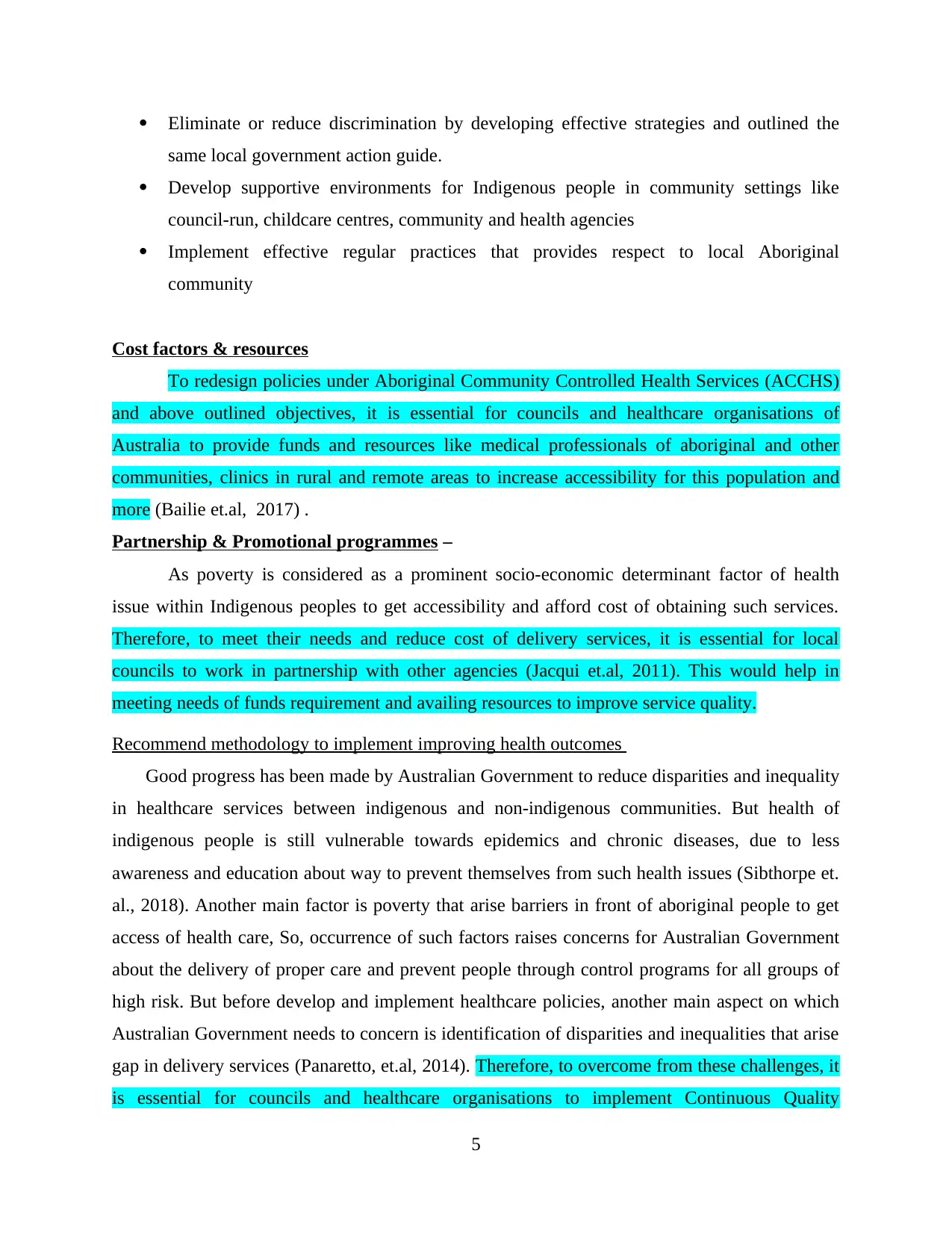
Eliminate or reduce discrimination by developing effective strategies and outlined the
same local government action guide.
Develop supportive environments for Indigenous people in community settings like
council-run, childcare centres, community and health agencies
Implement effective regular practices that provides respect to local Aboriginal
community
Cost factors & resources
To redesign policies under Aboriginal Community Controlled Health Services (ACCHS)
and above outlined objectives, it is essential for councils and healthcare organisations of
Australia to provide funds and resources like medical professionals of aboriginal and other
communities, clinics in rural and remote areas to increase accessibility for this population and
more (Bailie et.al, 2017) .
Partnership & Promotional programmes –
As poverty is considered as a prominent socio-economic determinant factor of health
issue within Indigenous peoples to get accessibility and afford cost of obtaining such services.
Therefore, to meet their needs and reduce cost of delivery services, it is essential for local
councils to work in partnership with other agencies (Jacqui et.al, 2011). This would help in
meeting needs of funds requirement and availing resources to improve service quality.
Recommend methodology to implement improving health outcomes
Good progress has been made by Australian Government to reduce disparities and inequality
in healthcare services between indigenous and non-indigenous communities. But health of
indigenous people is still vulnerable towards epidemics and chronic diseases, due to less
awareness and education about way to prevent themselves from such health issues (Sibthorpe et.
al., 2018). Another main factor is poverty that arise barriers in front of aboriginal people to get
access of health care, So, occurrence of such factors raises concerns for Australian Government
about the delivery of proper care and prevent people through control programs for all groups of
high risk. But before develop and implement healthcare policies, another main aspect on which
Australian Government needs to concern is identification of disparities and inequalities that arise
gap in delivery services (Panaretto, et.al, 2014). Therefore, to overcome from these challenges, it
is essential for councils and healthcare organisations to implement Continuous Quality
5
same local government action guide.
Develop supportive environments for Indigenous people in community settings like
council-run, childcare centres, community and health agencies
Implement effective regular practices that provides respect to local Aboriginal
community
Cost factors & resources
To redesign policies under Aboriginal Community Controlled Health Services (ACCHS)
and above outlined objectives, it is essential for councils and healthcare organisations of
Australia to provide funds and resources like medical professionals of aboriginal and other
communities, clinics in rural and remote areas to increase accessibility for this population and
more (Bailie et.al, 2017) .
Partnership & Promotional programmes –
As poverty is considered as a prominent socio-economic determinant factor of health
issue within Indigenous peoples to get accessibility and afford cost of obtaining such services.
Therefore, to meet their needs and reduce cost of delivery services, it is essential for local
councils to work in partnership with other agencies (Jacqui et.al, 2011). This would help in
meeting needs of funds requirement and availing resources to improve service quality.
Recommend methodology to implement improving health outcomes
Good progress has been made by Australian Government to reduce disparities and inequality
in healthcare services between indigenous and non-indigenous communities. But health of
indigenous people is still vulnerable towards epidemics and chronic diseases, due to less
awareness and education about way to prevent themselves from such health issues (Sibthorpe et.
al., 2018). Another main factor is poverty that arise barriers in front of aboriginal people to get
access of health care, So, occurrence of such factors raises concerns for Australian Government
about the delivery of proper care and prevent people through control programs for all groups of
high risk. But before develop and implement healthcare policies, another main aspect on which
Australian Government needs to concern is identification of disparities and inequalities that arise
gap in delivery services (Panaretto, et.al, 2014). Therefore, to overcome from these challenges, it
is essential for councils and healthcare organisations to implement Continuous Quality
5
Paraphrase This Document
Need a fresh take? Get an instant paraphrase of this document with our AI Paraphraser
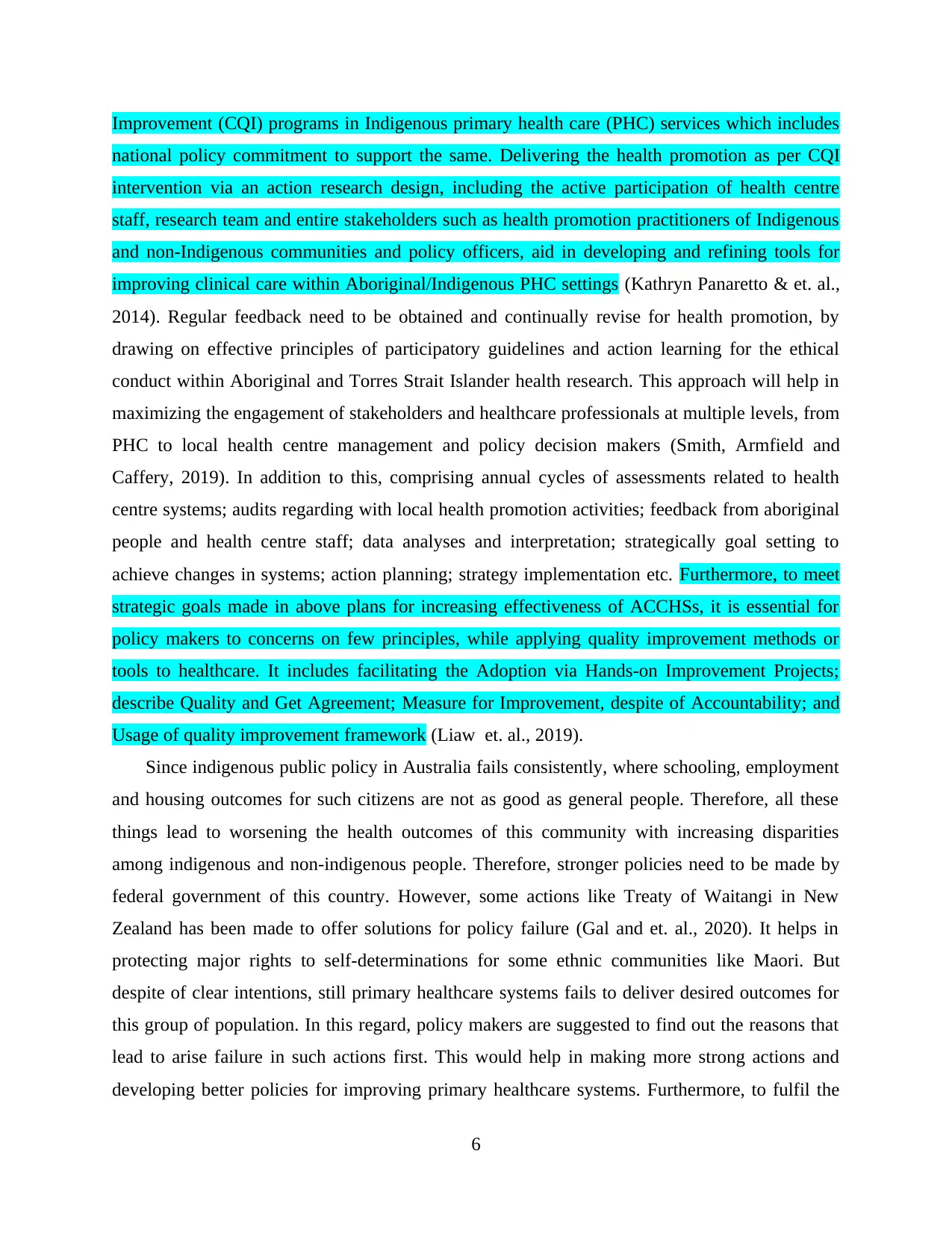
Improvement (CQI) programs in Indigenous primary health care (PHC) services which includes
national policy commitment to support the same. Delivering the health promotion as per CQI
intervention via an action research design, including the active participation of health centre
staff, research team and entire stakeholders such as health promotion practitioners of Indigenous
and non-Indigenous communities and policy officers, aid in developing and refining tools for
improving clinical care within Aboriginal/Indigenous PHC settings (Kathryn Panaretto & et. al.,
2014). Regular feedback need to be obtained and continually revise for health promotion, by
drawing on effective principles of participatory guidelines and action learning for the ethical
conduct within Aboriginal and Torres Strait Islander health research. This approach will help in
maximizing the engagement of stakeholders and healthcare professionals at multiple levels, from
PHC to local health centre management and policy decision makers (Smith, Armfield and
Caffery, 2019). In addition to this, comprising annual cycles of assessments related to health
centre systems; audits regarding with local health promotion activities; feedback from aboriginal
people and health centre staff; data analyses and interpretation; strategically goal setting to
achieve changes in systems; action planning; strategy implementation etc. Furthermore, to meet
strategic goals made in above plans for increasing effectiveness of ACCHSs, it is essential for
policy makers to concerns on few principles, while applying quality improvement methods or
tools to healthcare. It includes facilitating the Adoption via Hands-on Improvement Projects;
describe Quality and Get Agreement; Measure for Improvement, despite of Accountability; and
Usage of quality improvement framework (Liaw et. al., 2019).
Since indigenous public policy in Australia fails consistently, where schooling, employment
and housing outcomes for such citizens are not as good as general people. Therefore, all these
things lead to worsening the health outcomes of this community with increasing disparities
among indigenous and non-indigenous people. Therefore, stronger policies need to be made by
federal government of this country. However, some actions like Treaty of Waitangi in New
Zealand has been made to offer solutions for policy failure (Gal and et. al., 2020). It helps in
protecting major rights to self-determinations for some ethnic communities like Maori. But
despite of clear intentions, still primary healthcare systems fails to deliver desired outcomes for
this group of population. In this regard, policy makers are suggested to find out the reasons that
lead to arise failure in such actions first. This would help in making more strong actions and
developing better policies for improving primary healthcare systems. Furthermore, to fulfil the
6
national policy commitment to support the same. Delivering the health promotion as per CQI
intervention via an action research design, including the active participation of health centre
staff, research team and entire stakeholders such as health promotion practitioners of Indigenous
and non-Indigenous communities and policy officers, aid in developing and refining tools for
improving clinical care within Aboriginal/Indigenous PHC settings (Kathryn Panaretto & et. al.,
2014). Regular feedback need to be obtained and continually revise for health promotion, by
drawing on effective principles of participatory guidelines and action learning for the ethical
conduct within Aboriginal and Torres Strait Islander health research. This approach will help in
maximizing the engagement of stakeholders and healthcare professionals at multiple levels, from
PHC to local health centre management and policy decision makers (Smith, Armfield and
Caffery, 2019). In addition to this, comprising annual cycles of assessments related to health
centre systems; audits regarding with local health promotion activities; feedback from aboriginal
people and health centre staff; data analyses and interpretation; strategically goal setting to
achieve changes in systems; action planning; strategy implementation etc. Furthermore, to meet
strategic goals made in above plans for increasing effectiveness of ACCHSs, it is essential for
policy makers to concerns on few principles, while applying quality improvement methods or
tools to healthcare. It includes facilitating the Adoption via Hands-on Improvement Projects;
describe Quality and Get Agreement; Measure for Improvement, despite of Accountability; and
Usage of quality improvement framework (Liaw et. al., 2019).
Since indigenous public policy in Australia fails consistently, where schooling, employment
and housing outcomes for such citizens are not as good as general people. Therefore, all these
things lead to worsening the health outcomes of this community with increasing disparities
among indigenous and non-indigenous people. Therefore, stronger policies need to be made by
federal government of this country. However, some actions like Treaty of Waitangi in New
Zealand has been made to offer solutions for policy failure (Gal and et. al., 2020). It helps in
protecting major rights to self-determinations for some ethnic communities like Maori. But
despite of clear intentions, still primary healthcare systems fails to deliver desired outcomes for
this group of population. In this regard, policy makers are suggested to find out the reasons that
lead to arise failure in such actions first. This would help in making more strong actions and
developing better policies for improving primary healthcare systems. Furthermore, to fulfil the
6
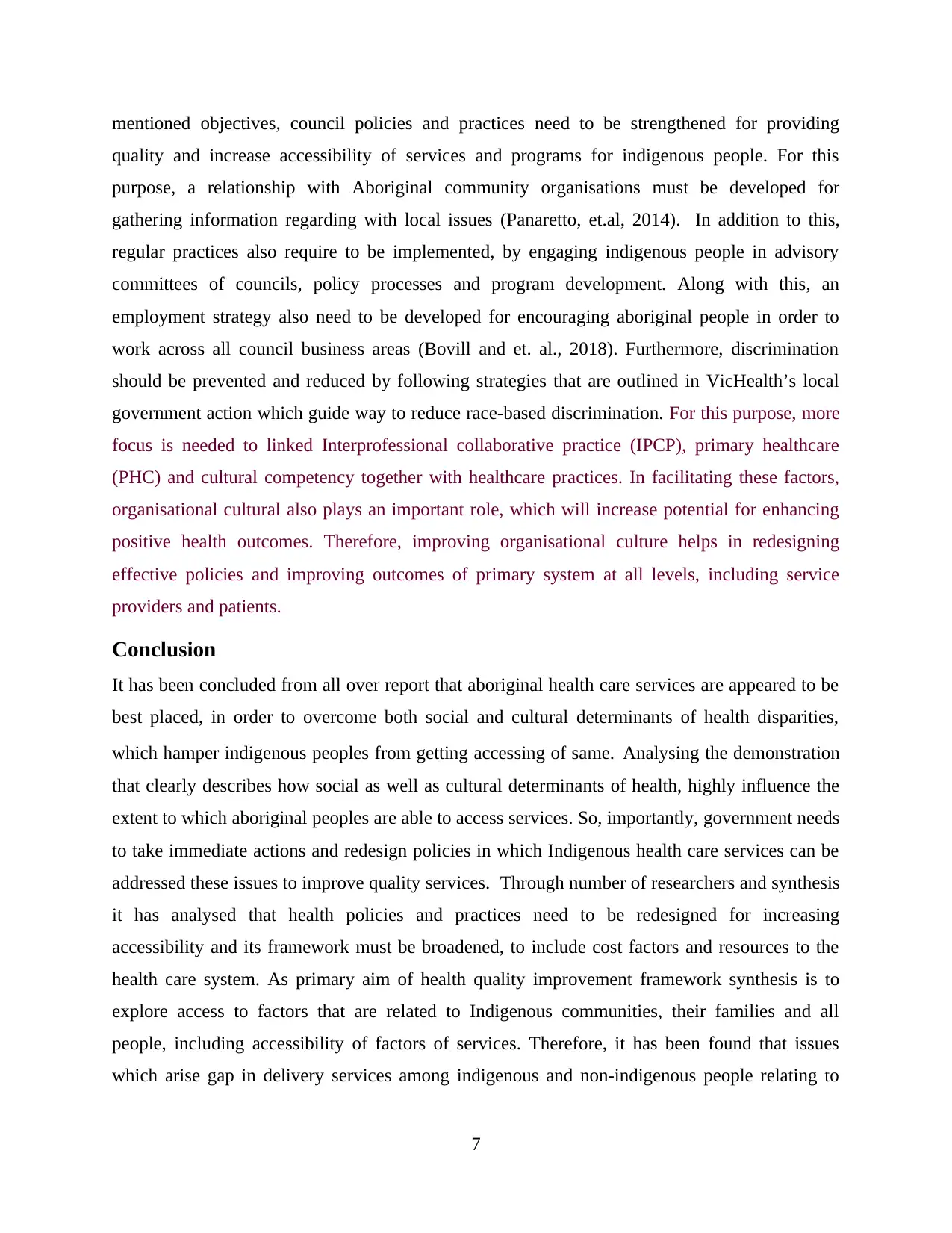
mentioned objectives, council policies and practices need to be strengthened for providing
quality and increase accessibility of services and programs for indigenous people. For this
purpose, a relationship with Aboriginal community organisations must be developed for
gathering information regarding with local issues (Panaretto, et.al, 2014). In addition to this,
regular practices also require to be implemented, by engaging indigenous people in advisory
committees of councils, policy processes and program development. Along with this, an
employment strategy also need to be developed for encouraging aboriginal people in order to
work across all council business areas (Bovill and et. al., 2018). Furthermore, discrimination
should be prevented and reduced by following strategies that are outlined in VicHealth’s local
government action which guide way to reduce race-based discrimination. For this purpose, more
focus is needed to linked Interprofessional collaborative practice (IPCP), primary healthcare
(PHC) and cultural competency together with healthcare practices. In facilitating these factors,
organisational cultural also plays an important role, which will increase potential for enhancing
positive health outcomes. Therefore, improving organisational culture helps in redesigning
effective policies and improving outcomes of primary system at all levels, including service
providers and patients.
Conclusion
It has been concluded from all over report that aboriginal health care services are appeared to be
best placed, in order to overcome both social and cultural determinants of health disparities,
which hamper indigenous peoples from getting accessing of same. Analysing the demonstration
that clearly describes how social as well as cultural determinants of health, highly influence the
extent to which aboriginal peoples are able to access services. So, importantly, government needs
to take immediate actions and redesign policies in which Indigenous health care services can be
addressed these issues to improve quality services. Through number of researchers and synthesis
it has analysed that health policies and practices need to be redesigned for increasing
accessibility and its framework must be broadened, to include cost factors and resources to the
health care system. As primary aim of health quality improvement framework synthesis is to
explore access to factors that are related to Indigenous communities, their families and all
people, including accessibility of factors of services. Therefore, it has been found that issues
which arise gap in delivery services among indigenous and non-indigenous people relating to
7
quality and increase accessibility of services and programs for indigenous people. For this
purpose, a relationship with Aboriginal community organisations must be developed for
gathering information regarding with local issues (Panaretto, et.al, 2014). In addition to this,
regular practices also require to be implemented, by engaging indigenous people in advisory
committees of councils, policy processes and program development. Along with this, an
employment strategy also need to be developed for encouraging aboriginal people in order to
work across all council business areas (Bovill and et. al., 2018). Furthermore, discrimination
should be prevented and reduced by following strategies that are outlined in VicHealth’s local
government action which guide way to reduce race-based discrimination. For this purpose, more
focus is needed to linked Interprofessional collaborative practice (IPCP), primary healthcare
(PHC) and cultural competency together with healthcare practices. In facilitating these factors,
organisational cultural also plays an important role, which will increase potential for enhancing
positive health outcomes. Therefore, improving organisational culture helps in redesigning
effective policies and improving outcomes of primary system at all levels, including service
providers and patients.
Conclusion
It has been concluded from all over report that aboriginal health care services are appeared to be
best placed, in order to overcome both social and cultural determinants of health disparities,
which hamper indigenous peoples from getting accessing of same. Analysing the demonstration
that clearly describes how social as well as cultural determinants of health, highly influence the
extent to which aboriginal peoples are able to access services. So, importantly, government needs
to take immediate actions and redesign policies in which Indigenous health care services can be
addressed these issues to improve quality services. Through number of researchers and synthesis
it has analysed that health policies and practices need to be redesigned for increasing
accessibility and its framework must be broadened, to include cost factors and resources to the
health care system. As primary aim of health quality improvement framework synthesis is to
explore access to factors that are related to Indigenous communities, their families and all
people, including accessibility of factors of services. Therefore, it has been found that issues
which arise gap in delivery services among indigenous and non-indigenous people relating to
7

both social, economic and cultural determinants regarding with their health hampered from
accessing care.
8
accessing care.
8
Secure Best Marks with AI Grader
Need help grading? Try our AI Grader for instant feedback on your assignments.
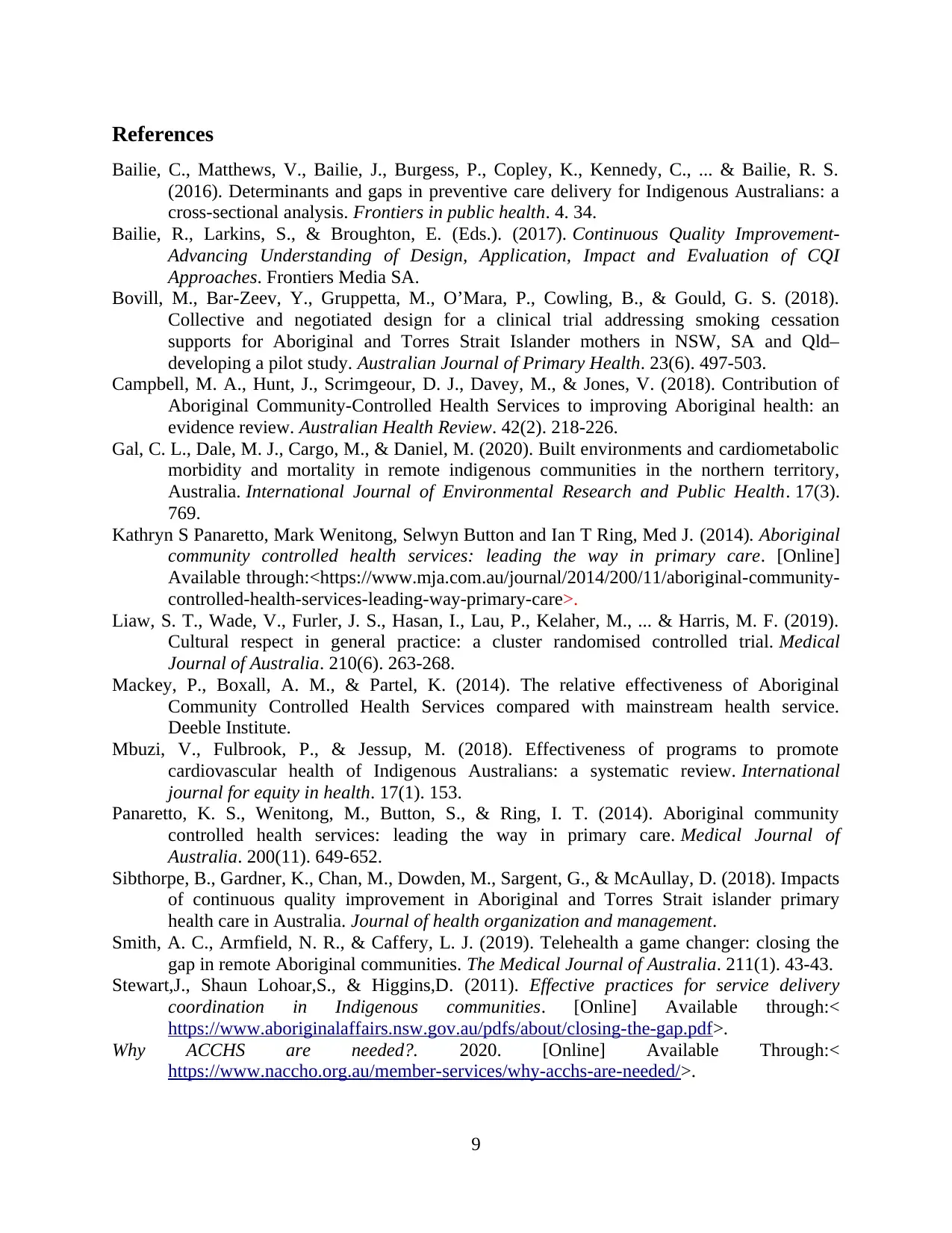
References
Bailie, C., Matthews, V., Bailie, J., Burgess, P., Copley, K., Kennedy, C., ... & Bailie, R. S.
(2016). Determinants and gaps in preventive care delivery for Indigenous Australians: a
cross-sectional analysis. Frontiers in public health. 4. 34.
Bailie, R., Larkins, S., & Broughton, E. (Eds.). (2017). Continuous Quality Improvement-
Advancing Understanding of Design, Application, Impact and Evaluation of CQI
Approaches. Frontiers Media SA.
Bovill, M., Bar-Zeev, Y., Gruppetta, M., O’Mara, P., Cowling, B., & Gould, G. S. (2018).
Collective and negotiated design for a clinical trial addressing smoking cessation
supports for Aboriginal and Torres Strait Islander mothers in NSW, SA and Qld–
developing a pilot study. Australian Journal of Primary Health. 23(6). 497-503.
Campbell, M. A., Hunt, J., Scrimgeour, D. J., Davey, M., & Jones, V. (2018). Contribution of
Aboriginal Community-Controlled Health Services to improving Aboriginal health: an
evidence review. Australian Health Review. 42(2). 218-226.
Gal, C. L., Dale, M. J., Cargo, M., & Daniel, M. (2020). Built environments and cardiometabolic
morbidity and mortality in remote indigenous communities in the northern territory,
Australia. International Journal of Environmental Research and Public Health. 17(3).
769.
Kathryn S Panaretto, Mark Wenitong, Selwyn Button and Ian T Ring, Med J. (2014). Aboriginal
community controlled health services: leading the way in primary care. [Online]
Available through:<https://www.mja.com.au/journal/2014/200/11/aboriginal-community-
controlled-health-services-leading-way-primary-care>.
Liaw, S. T., Wade, V., Furler, J. S., Hasan, I., Lau, P., Kelaher, M., ... & Harris, M. F. (2019).
Cultural respect in general practice: a cluster randomised controlled trial. Medical
Journal of Australia. 210(6). 263-268.
Mackey, P., Boxall, A. M., & Partel, K. (2014). The relative effectiveness of Aboriginal
Community Controlled Health Services compared with mainstream health service.
Deeble Institute.
Mbuzi, V., Fulbrook, P., & Jessup, M. (2018). Effectiveness of programs to promote
cardiovascular health of Indigenous Australians: a systematic review. International
journal for equity in health. 17(1). 153.
Panaretto, K. S., Wenitong, M., Button, S., & Ring, I. T. (2014). Aboriginal community
controlled health services: leading the way in primary care. Medical Journal of
Australia. 200(11). 649-652.
Sibthorpe, B., Gardner, K., Chan, M., Dowden, M., Sargent, G., & McAullay, D. (2018). Impacts
of continuous quality improvement in Aboriginal and Torres Strait islander primary
health care in Australia. Journal of health organization and management.
Smith, A. C., Armfield, N. R., & Caffery, L. J. (2019). Telehealth a game changer: closing the
gap in remote Aboriginal communities. The Medical Journal of Australia. 211(1). 43-43.
Stewart,J., Shaun Lohoar,S., & Higgins,D. (2011). Effective practices for service delivery
coordination in Indigenous communities. [Online] Available through:<
https://www.aboriginalaffairs.nsw.gov.au/pdfs/about/closing-the-gap.pdf>.
Why ACCHS are needed?. 2020. [Online] Available Through:<
https://www.naccho.org.au/member-services/why-acchs-are-needed/>.
9
Bailie, C., Matthews, V., Bailie, J., Burgess, P., Copley, K., Kennedy, C., ... & Bailie, R. S.
(2016). Determinants and gaps in preventive care delivery for Indigenous Australians: a
cross-sectional analysis. Frontiers in public health. 4. 34.
Bailie, R., Larkins, S., & Broughton, E. (Eds.). (2017). Continuous Quality Improvement-
Advancing Understanding of Design, Application, Impact and Evaluation of CQI
Approaches. Frontiers Media SA.
Bovill, M., Bar-Zeev, Y., Gruppetta, M., O’Mara, P., Cowling, B., & Gould, G. S. (2018).
Collective and negotiated design for a clinical trial addressing smoking cessation
supports for Aboriginal and Torres Strait Islander mothers in NSW, SA and Qld–
developing a pilot study. Australian Journal of Primary Health. 23(6). 497-503.
Campbell, M. A., Hunt, J., Scrimgeour, D. J., Davey, M., & Jones, V. (2018). Contribution of
Aboriginal Community-Controlled Health Services to improving Aboriginal health: an
evidence review. Australian Health Review. 42(2). 218-226.
Gal, C. L., Dale, M. J., Cargo, M., & Daniel, M. (2020). Built environments and cardiometabolic
morbidity and mortality in remote indigenous communities in the northern territory,
Australia. International Journal of Environmental Research and Public Health. 17(3).
769.
Kathryn S Panaretto, Mark Wenitong, Selwyn Button and Ian T Ring, Med J. (2014). Aboriginal
community controlled health services: leading the way in primary care. [Online]
Available through:<https://www.mja.com.au/journal/2014/200/11/aboriginal-community-
controlled-health-services-leading-way-primary-care>.
Liaw, S. T., Wade, V., Furler, J. S., Hasan, I., Lau, P., Kelaher, M., ... & Harris, M. F. (2019).
Cultural respect in general practice: a cluster randomised controlled trial. Medical
Journal of Australia. 210(6). 263-268.
Mackey, P., Boxall, A. M., & Partel, K. (2014). The relative effectiveness of Aboriginal
Community Controlled Health Services compared with mainstream health service.
Deeble Institute.
Mbuzi, V., Fulbrook, P., & Jessup, M. (2018). Effectiveness of programs to promote
cardiovascular health of Indigenous Australians: a systematic review. International
journal for equity in health. 17(1). 153.
Panaretto, K. S., Wenitong, M., Button, S., & Ring, I. T. (2014). Aboriginal community
controlled health services: leading the way in primary care. Medical Journal of
Australia. 200(11). 649-652.
Sibthorpe, B., Gardner, K., Chan, M., Dowden, M., Sargent, G., & McAullay, D. (2018). Impacts
of continuous quality improvement in Aboriginal and Torres Strait islander primary
health care in Australia. Journal of health organization and management.
Smith, A. C., Armfield, N. R., & Caffery, L. J. (2019). Telehealth a game changer: closing the
gap in remote Aboriginal communities. The Medical Journal of Australia. 211(1). 43-43.
Stewart,J., Shaun Lohoar,S., & Higgins,D. (2011). Effective practices for service delivery
coordination in Indigenous communities. [Online] Available through:<
https://www.aboriginalaffairs.nsw.gov.au/pdfs/about/closing-the-gap.pdf>.
Why ACCHS are needed?. 2020. [Online] Available Through:<
https://www.naccho.org.au/member-services/why-acchs-are-needed/>.
9

10
1 out of 12
Related Documents
Your All-in-One AI-Powered Toolkit for Academic Success.
+13062052269
info@desklib.com
Available 24*7 on WhatsApp / Email
![[object Object]](/_next/static/media/star-bottom.7253800d.svg)
Unlock your academic potential
© 2024 | Zucol Services PVT LTD | All rights reserved.





